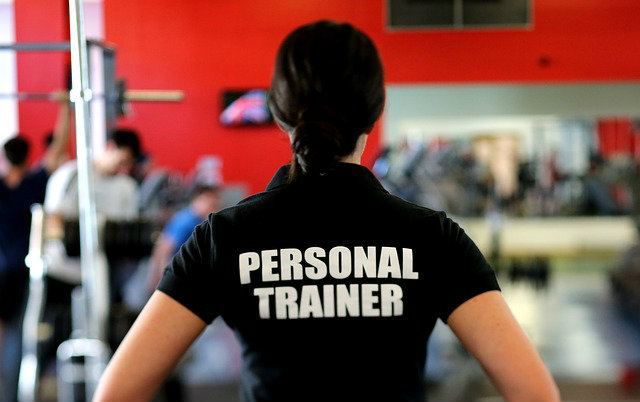 Reading Time: 6 minutes
Reading Time: 6 minutesNot one week into 2018, I found myself standing in a donut shop with some foodie girlfriends admiring anything that had marshmallows on it.
Store lamps beaming off the glaze of the baked goods on display, I saw my dreams of an improved eating habit flashing before me, and wondered, “Would this be the gateway donut? The sugar bomb that crashed my whole 2018 health plan to the ground?”
For the new year, I’d committed to logging my food into a nutrition app again and had made every scheduled workout the previous week. But could the burpees make up for the cream filling? How long would it take me to forgive myself for falling off the wagon if I indulged?
Should I just start over in 2019?
New Year Resolution Reality Check
It’s safe to say most of this year’s resolutions were written while people were on December vacation. How glorious it was to dream of the “future you” when you were well rested and had minimal work obligations. There we sat, eating the final slivers of holiday desserts and telling ourselves we would lose the last ten pounds starting the next month.
Then, the first full workweek of the new year rolled around, along with all the tasks that were on hold during vacation and the hefty holiday bills. The bottom dropped out. All energy was zapped, and the hopes of change dashed along with it.
It’s a wonder anyone still resolves to do much in the new year at all. But when the progress train flies off the tracks, is there a systematic way we can get back on course just as quickly?
A New Blueprint for Your New Year
At the first moment of failure (or, at least, once you’re done flipping out), step one is revisiting your original goal and evaluating if it was reasonable to begin with. Think of yourself as a consulting firm looking back in time at the goal’s timeline and structure. Evaluate the plan for improvement. (And there’s no need to fire yourself.)
Let’s nerd out on a weight-loss goal for a moment. If you planned to lose ten pounds by January 31st, and it didn’t happen, here is the calorie math behind that goal:
- Most exercise physiologists will tell to create a 3,500-calorie deficit to lose one pound.
- That’s a 500-calorie deficit per day, to lose one pound within a week.
- For the average adult, that means running five miles per day, or eating 500 calories less than your body requires, or some combination of the two.
- Even in following those marching orders, you’re looking at a four-pound weight loss per month.
Reality check: Ten pounds lost was never going to happen or the pounds were never going to stay off because the change was too extreme.
If after analyzing your original goal, you see that you set yourself up for failure by choosing an impossible goal or not researching your plan well enough, then it’s time to learn, forgive, and press the reset button.
For your next goal, ask a professional how long your overarching goal should take to attain. Seek the advice of a registered dietician and/or a certified personal trainer. Be warned, however, that their next question back to you will likely be how much time you have to dedicate to your vision.

Getting Time on Your Side
For the past seven years, I have habitually rolled out of bed, worked out, and returned home to get ready for work, not because it makes for better workouts, but because it is the most time-efficient and reliable strategy for me. Working out in the morning requires zero preparation the night before, takes the least amount of time out of my day, and guarantees the workout gets done.
If the wheels are falling off your resolution wagon, take a moment to scan through your daily activities and think about how time is escaping you. Do you press snooze for thirty minutes in the morning? Spend so much time socializing at work that you are unable to leave work on time? Watch a few hours of TV every night? Go to sleep so late that you can’t fathom working out in the morning?
Think of tightening your time management as earmarking room for a new reality. Almost any goal you set will require dedicated time. Make space for the change you’re seeking.
It may be that you’re declaring you need fifteen minutes of alone time to reflect at the end of the night, or you’re setting your alarm twenty minutes earlier to bike to work instead of driving. So, try turning off the TV a couple nights a week or limiting alcoholic beverages to weekends so you wake up less likely to snooze.
Ask yourself how much time per day do you need to make your goal happen? Troubleshoot your routine and line yourself up to win.

Set Mini Goals
Who doesn’t love instant gratification? Take your 2018 trajectory in a positive direction by setting small goals that allow for immediate satisfaction. Think of long-term goal setting as stacking up tiny victories to build a mountain of accolades.
Consider instant gratification habits such as the following to reinforce the pathway to big resolutions:
- Following a workout, take time to sit in your car, take deep breaths, and listen to your favorite song without distraction. Consider it a mini-meditation while your post-exercise endorphins have you adrift in joy.
- Identify a resolution buddy and make a pact to send a weekly wrap-up to that person. Include one win, one loss, and one idea for improvement.
- Set up prepared meals in a lunch box on a nightly basis. Take yourself out to a healthy lunch on Friday as a reward for a complete week.
- Stretch and foam roll on all the commercial breaks of the nightly news.
- Extend the daily dog walk by a tenth of a mile each week.
Let It Go
Humans “fail.” We are an imperfect group. What is amazing to me, however, is how long the self-criticism can last after we fall off course.
Go to any gym on a Monday and you will see trainers shaking their heads and grimacing as clients rattle off their weekend fitness and health faux pas: a missed workout, two piña coladas, a buttery pretzel, or a night of zero sleep. What you might miss in the scenario, however, is that the client has shown back up to do work.
What if instead of carrying the guilt of straying from the path for days, we thought to ourselves, “That was fun,” and then dedicated ourselves to the quickest turnaround time possible in getting back to our next healthy meal or workout.
There has to be some levity, some freedom, and some wiggle room in goal setting that allows you to stray from perfection, without feeling like you need to ground yourself for a week. Seek overall balance, and let go of deviations from the course. Achieve your smaller goals to hook back in and keep going.

Train Your Inner Coach
Each of us has an incredible internal dialogue, most of which goes unshared. We have our own strategies to relax, recuperate, and calm ourselves in times of stress. We also have our own triggers, obsessions, and fears of failure.
At the end of each day, take the time to tell yourself you’ve done a good job at a few things, and think about one thing you can do to make tomorrow easier for yourself or someone else. Developing your ability to guide yourself toward success can be the greatest new year’s resolution guarantor of all.
And in case you were wondering, I ate the donut. It was an incredible sea salt caramel. No regrets.




